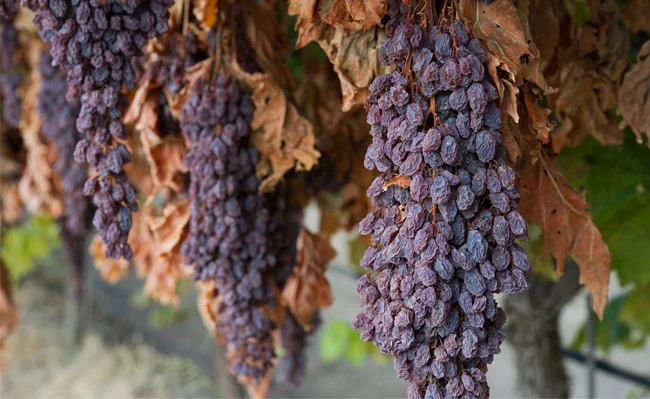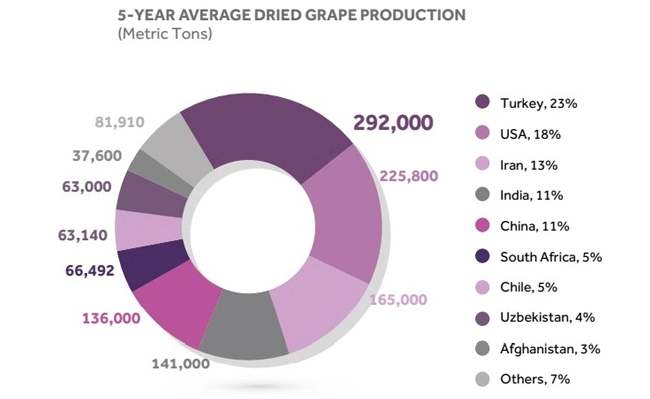Dried grapes or more commonly raisins are classified nowadays as dried fruits. However, they are a special type of dried fruit with an extremely sweet taste and lots of health benefits. They have been around for a long time, but are yet to be fully understood. There is still a lot we do not know about raisins. They never cease to startle us in many aspects.
In this article, we try to provide a few interesting facts about raisins, from their history to nutrition, to health benefits and uses. We will also take a look at their benefits to women and what happens if you eat too many of them. Finally, we will answer a few of your questions about dried grapes. But first, read this interesting story about a misfortunate fox.
- The Fox and The Dried Grapes
- 1. How Raisons Were Born
- 2. How Raisins Spread Throughout the World
- 3. Top Raisin Producing/Exporting Countries
- 4. General Types of Raisins
- 5. What Raisins Taste Like
- 6. The Health Benefits of Raisins
- 7. Raisins Benefits to Females
- 8. The Sugar Content of Raisins
- 9. What Chefs Say about Raisins
The Fox and The Dried Grapes
On a very hot day in the summer, a thirsty fox was wandering along a road when he saw a vine curled around a tree trunk, and a big bunch of juicy grapes was dangling from it. “Well, well,” he thought to himself, “wouldn’t those grapes be just the kind of thing to quench my thirst on this hot day?”
But the grapes were too high up for the fox to reach. Even when he got up on his hind legs, he couldn’t quite get them. So he decided to jump. He jumped as high as he could, but he couldn’t get near them. He took a run and jumped even higher. Still no luck.
He jumped again and again until he was so hot that he had to give up. “Oh well,” he said as he walked away, “I really don’t care. They are probably dried grapes anyway.”
Note: The original story was titled “The Fox and The Grapes.”

1. How Raisons Were Born
Raisins are dried grapes. There are now many varieties of them consumed as popular snacks and ingredients across the globe. But there was a time when there were no raisins at all. They came to exist totally by accident.
Scholars say that the first raisins were discovered in pre-historic times (probably ancient Persia or Egypt) when some grapes were accidentally left to dry in the sun. Growers tasted the wrinkled fruits; they tasted sweet. They liked them, so they kept them.
Shortly after, the dried grape’s popularity has spread to the Mediterranean and the rest of Europe. From there, it found its way to the new world. But up until recently, growers couldn’t determine which grape varieties would produce the best raisins.

2. How Raisins Spread Throughout the World
Wall paintings from ancient times show that dried fruits were eaten and used as decoration in the Mediterranean parts of Europe, Persia, and Egypt. For example, historical evidence shows that dried grapes were used to adorn places of worship or were awarded as prizes in sporting events.
Wall paintings from ancient times show that dried fruits were eaten and used as decoration in the Mediterranean parts of Europe, Persia, and Egypt. For example, historical evidence shows that dried grapes were used to adorn places of worship or were awarded as prizes in sporting events.
The processing technique for making dried grapes has probably been known for thousands of years, and evidence of their production has been discovered in the writings of ancient Egyptians. The ancient Armenians and Phoenicians were perhaps the first to develop viticulture, which is the process of grape growing and collecting. The Armenians established their vineyards in Persia (Iran, Turkey, Iraq). These growing areas had the ideal climate for making raisins and were close to Rome, Greece, as the primary markets.
But the shipping methods were poor, and dried grapes wouldn’t maintain their quality for long distances. However, the problem vanished in the 11th century by returning knights from the Crusades who brought dried grape samples back to Europe. They had discovered it during their travels through the Mediterranean and Persia. There was a considerable demand for dried grapes at home. Shortly after that, packing and shipping systems had developed enough for raisins to be sent all over Northern Europe.
In the 18th century, the Queen of Spain, Isabella, sent ministers to Mexico to teach natives about religion. While they were lecturing and teaching, the ministers also passed on their knowledge of viticulture. They used grapes for sacramental wines and also planted Muscat grapes for raisins.
During the late 1800s, Spanish missionaries from Mexico brought grapes to the United States. They began teaching Californians how to establish vineyards. Those early vineyards were primarily intended to make wines, many of which are still produced today. The raisin industry in the US was born when, in 1873, vineyards discovered that they could make quicker profits by drying the fruits.
3. Top Raisin Producing/Exporting Countries
Turkey is the leading producer of dried grapes (raisins, sultanas, and currents) in the world. In 2020, the country produced 22% (271,000 M T) of the global share. This was followed by the United States and Iran with 16% (196,000 M T) and 15% (180,000 M T) shares, respectively.
Turkey remains the leading exporting country of dried grapes, accounting for 31% of the global shares with 267,231 M T, followed by Iran and the United States, each with 9%.


4. General Types of Raisins
Raisins is a general name for a little, colorful (light green, green, dark green, brown, dark brown, golden, etc.) dried grape that is eaten as a snack or used in cooking, baking, and dressings. Normally when people say raisins, they mean one of these three kinds of dried grape (for more information, head to another article about 6 different types of raisins that you can find in a grocery store):
- Raisins
- Raisins are a special type of grape (Thompson Seedless variety) that has been dried for around three weeks after receiving no to minimal pre-treatment. They are soft, sweet, and juicy and come in different sizes, tastes and colors depending on the type of grape used.
- Sultanas
- Sultanas are made from seedless grapes (Thompson Seedless variety). They are darker in color but soft, sweet, and juicy like raisins. Sultanas are usually pre-treated with a color-stabilizer before drying.
- Currants
- Currants are tiny, dark brown grapes that have been dried naturally. They have a sweet, tangy, and intense flavor. They are made from a variety of small, seedless grapes such as Black Corinth.
Raisins, sultanas, and currants are highly nutritious food ingredients and make good substitutes for each other. The only tiny difference is in a serving of 28 grams; sultanas have a higher calorie content (106) than raisins (95) or currants (79). So currants are more weight-loss friendly than other dried grapes.
| Raisins | Sultanas | Currants | |
|---|---|---|---|
| Calories | 95 | 106 | 79 |
| Carbs | 22 grams | 22 grams | 21 grams |
| Protein | 1 gram | 1 gram | 1 gram |
| Fat | 0 grams | 0 grams | 0 grams |
| Fiber | 1 gram | 2 grams | 2 grams |
| Sugar | 17 grams | 21 grams | 19 grams |
| Potassium | 6% of the RDI | 8% of the RDI | 7% of the RDI |
| Vitamin C | 1% of the RDI | 1% of the RDI | 2% of the RDI |
| Vitamin K | 1% of the RDI | 1% of the RDI | 1% of the RDI |
To avoid confusion, we use the term “raisin” in its general sense to mean all types of dried grapes that also include sultanas and currants. Whenever the application calls for a specific kind of dried grape, we will use the exact term accordingly.
5. What Raisins Taste Like
It is surprising and weird that raisins, sultana, and currants don’t taste anything like fresh grapes, possibly because the drying process concentrates the sugar content in the fruit.
They all have slightly different tastes. For example, Raisins and sultanas are soft, sweet, and juicy, while currants have a sweet, tangy, and intense flavor.
Golden raisins are chewier and fruitier, while natural brown raisins can be dry and grainy with a super sweet taste. On the other hand, golden raisins are fleshy and soft and have a unique flavor.
6. The Health Benefits of Raisins
Raisins are good for digestion health
Research on raisins shows they are a great source of fiber, which is good for digestion. Fiber can help your body digest what you eat and prevent constipation and lose weight by keeping you full for a longer time. Eating one-half cup of raisins gives you 3.3 grams of fiber. This amount is 25 percent of the fiber your body needs daily. Moreover, fiber can also reduce the effects of highly concentrated sugar in raisins on your blood sugar levels. However, that doesn’t mean you indulge in raisins.
Raisins are healthy for the heart
Although it’s not that much, raisins contain iron, good for heart health. Most people following a vegan or vegetarian diet may experience iron deficiency. That’s when raisins come to help. One-half cup of raisins can give you at least 7 percent of the iron your body needs per day. Additionally, iron helps the body make red blood cells. Therefore, eating raisins can lead to a healthier life and prevent anemia.
Raisins contain protein
Even a small amount of protein counts. Especially for people who don’t eat meat or any other animal-based products. While the amount of protein in raisins is not as much as in pistachios, raisins can still help the body receive this essential nutrient. Furthermore, protein can prevent the blood sugar level from getting higher by eating raisins.
Raisins are packed with antioxidants
Grapes are full of antioxidants. Raisins have this benefit too. They are high in a specific type of antioxidants called polyphenols. Antioxidants fight free radicals, which are harmful to the body and may lead to chronic diseases, such as cancer. Antioxidants can also reduce inflammation and boost brain function. Therefore, eating raisins may protect the body against brain-related problems like Alzheimer’s.
They are beneficial to the bones
Calcium is one of the minerals that your body needs every day. Raisins have 45 milligrams of calcium in every half-cup. This amount can give your body almost 4 percent of the daily recommended calcium, which can make your bones and teeth stronger.
(Source: www. healthline.com)
7. Raisins Benefits to Females
Raisins in general, black raisins in particular, are very beneficial to women’s health. Black raisins water (made by soaking black raisins in water overnight and straining them the following day) contains the vitamins and minerals of raisins without the sugar content. Black raisin water plays many roles in women’s health. For example, it is believed that black raisin water plays the following functions:
- Help to detoxify the body
- Work as a blood purifier
- Provide benefits against Polycystic ovary syndrome (PCOS)
- Help regulate menses
- Help eliminate menstrual issues
- Help increase conception
- Help relieve constipation during pregnancy
Note: Although scientific research has proven most of these claims, it’s important that you do not take them as medical advice.
8. The Sugar Content of Raisins
Like other dried fruits, dried grapes have a high sugar concentration (about 30% fructose and 28% Glucose). For this reason, they are sometimes called “nature’s candy.”
When stored for an extended period, the sugar can crystallize inside the fruit, making the dried grapes scratchy, but it doesn’t change their usability. These sugar grains can dissolve by soaking the fruit in hot water or other fluids.
9. What Chefs Say about Raisins
Cooking with dried grapes is very easy. Just add them directly from the package to the recipe. You can also soften, chop, or soak them before using them if you want.
You can use them as a powerful energy booster snack in your everyday diet, especially for children and athletes. You can eat them right out of hand or add them to your savory salads, bread, muffins, cookies, and desserts.
Generally, you can include dried grapes in your daily diets in the following ways:
- Add to a cheese platter
- Dried grapes, especially raisins, can make a gourmet addition to a cheese platter. They work best and pair nicely with creamy brie, nuts, and crackers.
- Eat as a morning or afternoon snack
- You can eat dried grapes plain or add them to yogurt to create a more substantial snack.
- Mix them in a trail mix
- Combine raisins with nuts (peanuts, cashews, and pistachios), and you will have a healthy trail mix.
- Add to oatmeal
- A small sprinkling of raisins, sultanas, and currants adds natural sweetness to your porridge.
- Add to baked goods
- One great way to sweeten baked goods with dried grapes is to add them to muffins, granola bars, and cookies. They can soak up other flavors and make the finished product even tastier.
- Add to salads
- Dried grapes are excellent for adding sweet taste and texture, paired with bitter greens and crunchy nuts.
- Add to savory dishes
- They can be added to savory dishes such as curries, meatballs, chutneys, and rice pilaf. Currants often work best due to their small size.
(Source: www.healthline.com)
conclusion
We learned the good and the bad about raisins in this article. Read the disadvantages of eating raisins to see the ugly side of raisins, too. We just tried to offer facts about raisins’ history and benefits. None of our suggestions in this and other articles should be considered expert advice. Please do not act on them without consulting your medical advisor first.
Now, is there anything about dried grapes that we have left out? Please share with us in the comment section.
FAQ


Keep doing this work it really help me to learn new things and thank you for this amazing post [……delited………]
Thanks for providing this informative blog. You have well explained the origin of raisin which i believe only few people knows. Nice Article! You post very informative article on this topic, its very helpful for users who loves raisins and also the types and benefits of it. Thanks You.
Your post was beneficial for me. After reading your post I came across some more benefits of Raisins. Thank You.
Today I study your Post and learned a lot about the raisin . keep posting these type of beneficial blogs .